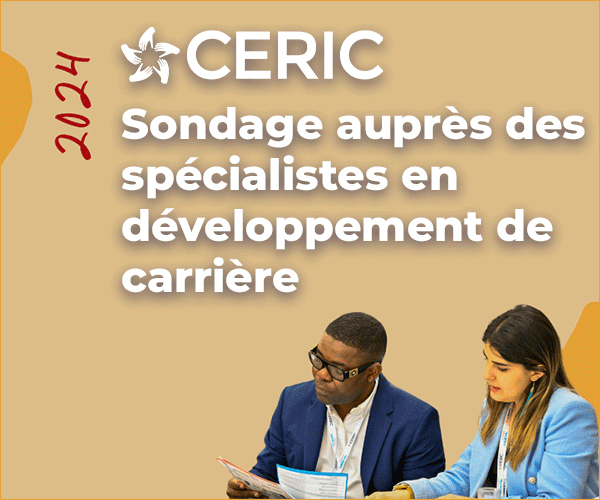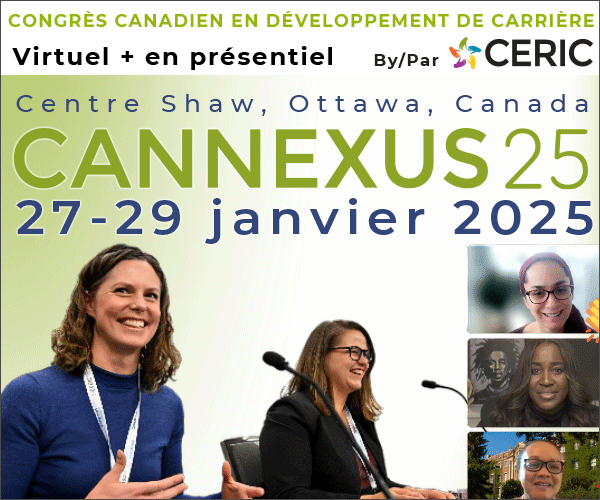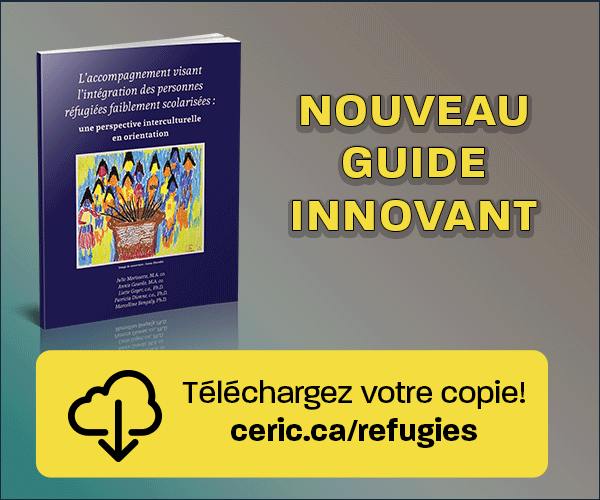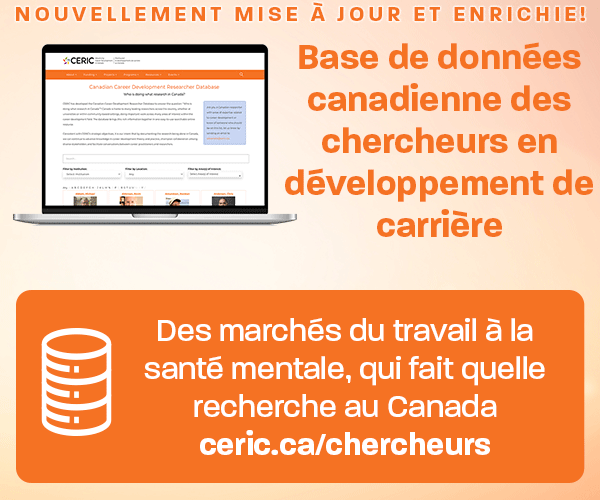Infusions culturelles et sables mouvants
Ce qui aide et entrave la prise de décision de carrière des jeunes indigènes
DOI :
https://doi.org/10.53379/cjcd.2023.345Mots-clés :
indigène, jeunes adultes, Prise de décision concernant la carrièreRésumé
Les jeunes adultes indigènes connaissent des taux de chômage disproportionnés, qui sont exacerbés par des facteurs systémiques tels que la pauvreté et l'oppression (Britten & Borgen, 2010). Malgré ces défis, de nombreux jeunes adultes indigènes réussissent bien dans leurs études et dans leur recherche d'emploi (Bougie et al., 2013). Cette étude a exploré ce qui a aidé et entravé la prise de décision de carrière de 18 jeunes adultes indigènes du Canada qui se considèrent comme ayant de bons résultats à cet égard. À l'aide de la technique améliorée de l'incident critique (ECIT), une méthode de recherche qualitative qui se concentre sur les facteurs aidants et entravants (Butterfield et al., 2009), 13 catégories ont été identifiées : (a) Famille/Relations et engagements, (b) Fixer des objectifs/Prendre des initiatives/Concentrer ses intérêts, (c) Soutien de la communauté/mentors, (d) Une manière saine (physique, mentale, sociale), (e) Trouver un sens/motivation et contribuer, (f) Réseautage et qui vous connaissez, (g) Facteurs systémiques/externes (institution, (g) Facteurs systémiques/externes (institution, marché du travail, sexisme, racisme, aspects interpersonnels), (h) Situation financière, (i) Connaissance/information/certitude, (j) Expérience (travail/vie privée), (k) Possibilités d'éducation/formation et éducation spécialisée, (l) Origine autochtone/facteurs culturels, et (m) Courage et estime de soi (vs. peur/doute de soi/des autres).
Références
Amundson, N. E., Borgen, W. A., Iaquinta, M., Butterfield, L. D., & Koert, E. (2010). Career decision-making from the decider’s perspective. The Career Development Quarterly, 58(4): 336-351. https://doi.org/10.1002/j.2161-0045.2010.tb00182.x
Arnett, J. J. (2000). Emerging adulthood: A theory of development from the late teens through the twenties. American Psychologist, 55(5), 469–480. https://doi.org/10.1037/0003-066X.55.5.469
Blustein, D. L. (2011). A relational theory of working. Journal of Vocational Behavior, 79(1), 1-17. https://psycnet.apa.org/doi/10.1016/j.jvb.2010.10.004
Borgen, W., & Hiebert, B. (2006). Career guidance and counselling for youth: What adolescents and young adults are telling us. International Journal for the Advancement of Counselling, 28: 389-400. https://DOI10.1007/s10447-006-9022-5
Borgen, W., Buchanan, M., Mathew, D., & Nishikawara, R. (2021). Career transition of immigrant young people: Narratives of success. Canadian Journal of Counselling and Psychotherapy, 55(1), 158-182. https://doi.org/10.47634/cjcp.v55i1.69129
Bougie, E., Kelly-Scott, K., & Arriagada, P. (2013). The education and employment experiences of First Nations people living off reserve, Inuit, and Métis: Selected findings from the 2012 Aboriginal peoples survey. Social and Aboriginal Statistics Division (Catalogue no. 89-653-X – No. 001). https://www150.statcan.gc.ca/n1/en/pub/89-653-x/89-653-x2013001-eng.pdf?st=mRfDjOlF
Britten, L. & Borgen, W. (2010). Indigenous footprints along the career journey. Procedia Social and Behavioural Sciences, 5: 104-115. https://doi.org/10.1016/j.sbspro.2010.07.059
Butterfield, L. D., Borgen, W. A., Amundson, N. E., & Maglio, A.-S. T. (2005). Fifty years of the critical incident technique: 1954-2004 and beyond. Qualitative Research, 5(4), 475-497. https://doi.org/10.1177/1468794105056924
Butterfield, L. D., Borgen, W. A., Maglio, A.-S. T., & Amundson, N. E. (2009). Using the Enhanced Critical Incident Technique in counselling psychology research. Canadian Journal of Counselling, 43(4), 265-282. https://cjc-rcc.ucalgary.ca/article/view/58863
Canadian Psychological Association. (2018). Psychology’s response to the Truth and Reconciliation Commission of Canada’s report. https://cpa.ca/docs/File/Task_Forces/TRC%20Task%20Force%20Report_FINAL.pdf
Caverley, N. Stewart, S., & Shepard, B. C. (2014). Through an Aboriginal lens: Exploring career development and planning in Canada. In Shepard, B. C., & Mani, P. S. (Eds.), Career development practice in Canada: Perspectives, principles, and professionalism (pp. 297-330). https://ceric.ca/career-development-practice-in-canada-perspectives-principles-and-professionalism/
Drummond, D., Sharpe, A., Murray, A., & Mask, N. (2017). The contribution of Aboriginal people to future labour force growth in Canada. Centre for the Study of Living Standards (CSLS). https://www-deslibris-ca.ezproxy.library.ubc.ca/ID/10092687
Garrett, M. T., & Herring, R. D. (2001). Honouring the power of relation: Counseling Native adults. The Journal of Humanistic Counseling, Education, and Development, 40(2):139-160. https://doi-org.ezproxy.library.ubc.ca/10.1002/j.2164-490X.2001.tb00113.x
Flanagan, J.C (1954). The critical incident technique. Psychological Bulletin, 51(4), 327-358. https://psycnet.apa.org/doi/10.1037/h0061470
Goodwill, A., Buchanan, M. J., Borgen, W., Mathew, D., DuMerton, L., Clegg, D., Becker, S., & McDaniels, M. (2019). From knowledge to wisdom: Indigenous women’s narratives of doing well with career decision making. Canadian Journal of Career Development, 18(2): 35-46. https://cjcd-rcdc.ceric.ca/index.php/cjcd/article/view/30
Government of Canada. (2011). Canada Year Book 2011: Aboriginal peoples. https://www150.statcan.gc.ca/n1/pub/11-402-x/2011000/chap/ap-pa/ap-pa-eng.htm
Hoffman, L. L., Jackson, A. P., & Smith, S. A. (2005). Career barriers among Native American students living on reservations. Journal of Career Development, 32(1): 31-45. https://doi.org/10.1177/0894845305277038
Kirkness, V. J., & Barnhardt, R. (2016). First Nations and higher education: The four r’s—respect, relevance, reciprocity, responsibility. Journal of College and University Student Housing, 42(2), 94–109 (Reprinted from “First Nations and higher education: The fourr’s—respect, relevance, reciprocity, responsibility,” 1991, Journal of American Indian Education, 30[3], 1–15)
McCormick, R. M. (1994). The facilitation of healing for the First Nations people of British Columbia. [Unpublished doctoral dissertation]. The University of British Columbia. https://www.nxtbook.com/nxtbooks/acuho/journal_vol42no2/index.php#/p/Intro
McCormick, R. M., & Amundson, N. E. (1997). A career-life planning model for First Nations people. Journal of Employment Counseling, 34(4), 171-179. https://doi.org/10.1002/j.2161-1920.1997.tb00467.x
McDaniel, M. M., Borgen, W. A., Buchanan, M. J., Butterfield, L. D., & Amundson, N. E. (2020). The philosophical underpinnings of the enhanced critical incident technique. Canadian Journal of Counselling and Psychotherapy, 54(4), 738-755. https://doi.org/10.47634/cjcp.v54i4.68139
Neblett Jr, E. W., Rivas‐Drake, D., & Umaña‐Taylor, A. J. (2012). The promise of racial and ethnic protective factors in promoting ethnic minority youth development. Child Development Perspectives, 6(3), 295-303. https://doi.org/10.1111/j.1750-8606.2012.00239.x
Pidgeon, M. (2016). More than a checklist: Meaningful Indigenous inclusion in higher education. Social Inclusion, 4(1), 77-91. https://doi.org/10.17645/si.v4i1.436
Schultheiss, D. E. P. (2007). The emergence of a relational cultural paradigm for vocational psychology. International Journal for Educational and Vocational Guidance, 7(3), 191-201. https://doi.org/10.1007/s10775-007-9123-7
Statistics Canada. (2013, May 8). Aboriginal peoples in Canada: First Nations people, Métis and Inuit, 2011 National household survey. http://www.statcan.gc.ca/daily-quotidien/130508/dq130508a-eng.htm
Statistics Canada. (2017, October 25). Aboriginal peoples in Canada: Key results from the 2016 census. https://www150.statcan.gc.ca/n1/daily-quotidien/171025/dq171025a-eng.htm
Stewart, S. L. & Reeves, A. (2013). Intersections of career development and post-secondary education for Indigenous students: Exploring the integrity of social and cultural issues. The Canadian Journal of Career Development, 12(2), 92-103. https://cjcd-rcdc.ceric.ca/index.php/cjcd/article/view/199
Truth and Reconciliation Commission of Canada (2015). Honouring the truth, reconciling for the future: Summary of the final report of the Truth and Reconciliation Commission of Canada. http://www.trc.ca/websites/trcinstitution/File/2015/Honouring_the_Truth_Reconciling_for_the_Future_July_23_2015.pdf
U.S. Department of Education. (1998). American Indians and Alaska natives in postsecondary education. Washington, DC: U.S. Government Printing Office.
Usalcas, J. (2011). Aboriginal people and the labour market: Estimates from the labour force survey, 2008-2010. Statistics Canada (Catalogue No. 71-588-X, no.3). https://www150.statcan.gc.ca/n1/en/pub/71-588-x/71-588-x2011003-eng.pdf?st=pJq99gGM
Vizenor, G. (2008). Survivance: Narratives of native presence. University of Nebraska Press.
Woolsey, L. K. (1986). The critical incident technique: An innovative qualitative method of research. Canadian Journal of Counselling, 20(4), 242-254. https://cjc-rcc.ucalgary.ca/article/view/59733

Téléchargements
Publié-e
Comment citer
Numéro
Rubrique
Licence
(c) Tous droits réservés La Revue canadienne de développement de carrière 2023

Cette œuvre est sous licence Creative Commons Attribution - Pas d'Utilisation Commerciale - Pas de Modification 4.0 International.












